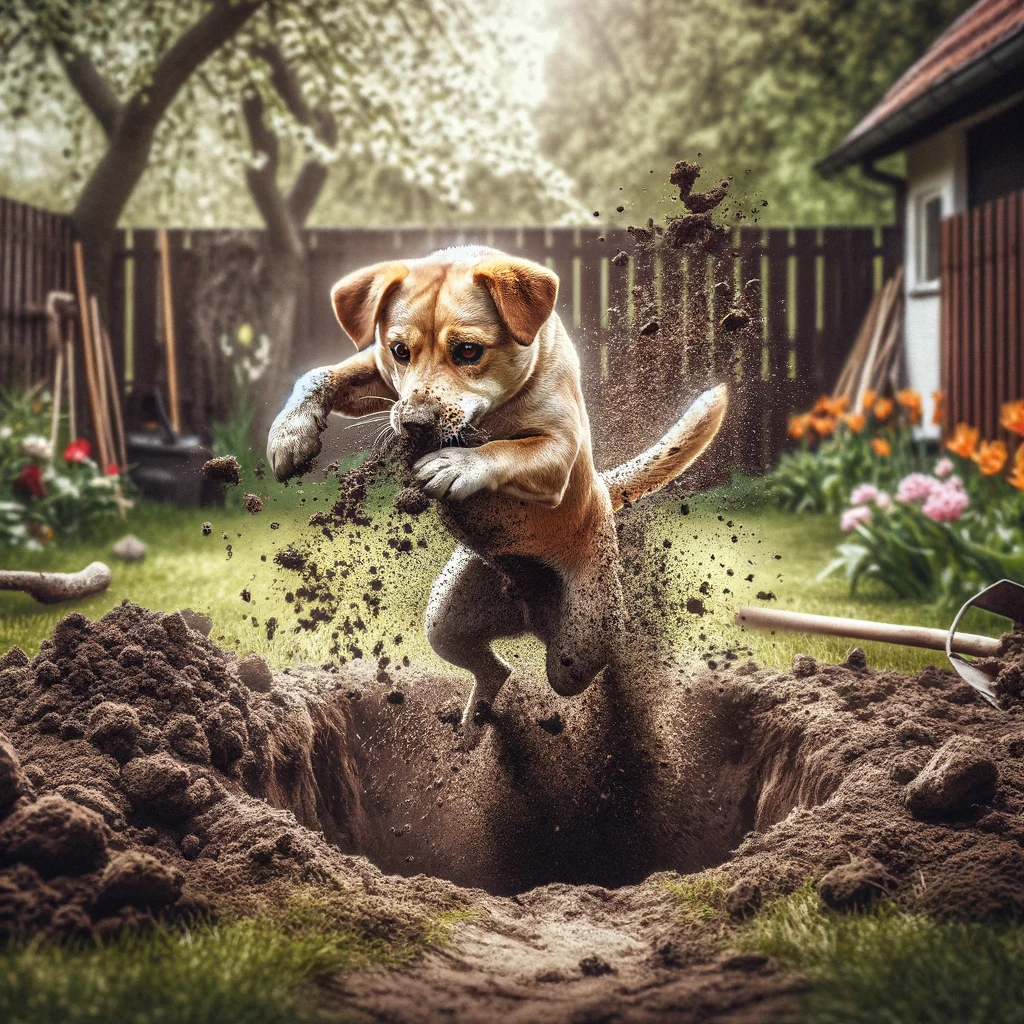Dog crate training is an important part of caring for your new puppy or dog. It offers various benefits that promote a happy and healthy life together.
Think of a dog crate as a cozy bedroom for your pup, a space where they can retreat to for solitude and rest. It’s not just a training tool, but a way to ensure safety during travel and times when you can’t provide direct supervision.
By incorporating positive reinforcement, you can help your pet view the crate as a positive space. This greatly assists with housebreaking, anxiety reduction, and establishing a routine.

Key Takeaways
- Choose the right size and type of crate to ensure your dog’s comfort and safety.
- Establish a positive association with the crate through treats, meals, and comfortable bedding.
- Develop a consistent routine for meals, potty breaks, and crate time to foster security and predictability.
- Address training challenges with patience, using positive reinforcement to overcome anxiety and reluctance.
- Gradually increase crate time and introduce alone time to build independence and trust in the crate as a safe space.
Dog Crate Training Basics
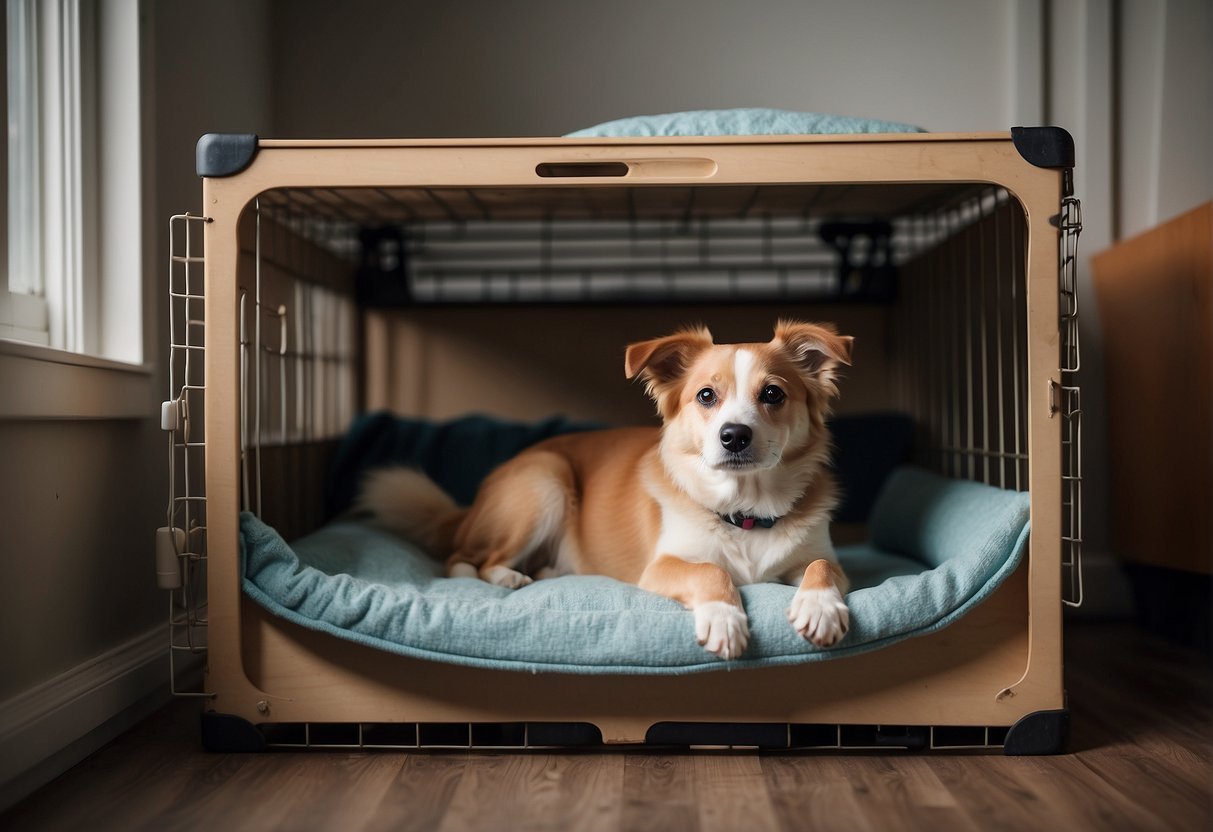
Crate training is an effective method to provide your dog their own safe den-like area, which taps into their natural instinct for a personal, snug space.
By using strategic training and positive reinforcement, you can create a comfortable environment for your puppy or dog. This makes the crate a place of security rather than confinement.
The Humane Society of the United States says this:
“The training process
Crate training can take days or weeks, depending on your dog’s age, temperament and past experiences. It’s important to keep two things in mind while crate training: The crate should always be associated with something pleasant and training should take place in a series of small steps. Don’t go too fast.”
Right Size, Right Location
Before you begin, choose the right size crate for your dog or puppy. The crate should be large enough for them to stand up, turn around, and lie down comfortably, but not so large that they might use one end as a bathroom.
Initially, place the crate in a high-traffic area so that your dog doesn’t feel isolated. Choosing a crate that blends in with your decor will help it not feel out of place. Start with short, supervised periods to get your puppy accustomed to the space.
- Short-duration confinement: Begin with 5-10 minute sessions and gradually increase as your dog becomes more comfortable.
- Consistency is key: Regularity helps your dog understand and adapt to the routine faster.
Creating a Positive Association
To foster a positive relationship with the crate, introduce it as a rewarding space.
Enticing your dog to enter with treats or a favorite toy can help establish a positive association. Each time your dog goes into their crate, respond with verbal praise, making the experience enjoyable.
- Mealtime in the crate: Feeding meals in the crate can further associate it with pleasant experiences.
- Comfort items: Add a soft blanket or a piece of your clothing to make the space more welcoming.
Remember, patience and positivity are vital components of crate training your dog. Each dog is unique, and the time it takes to crate train will vary, so adjust your approach as needed for your furry friend’s comfort and security.
Developing a Crate Routine
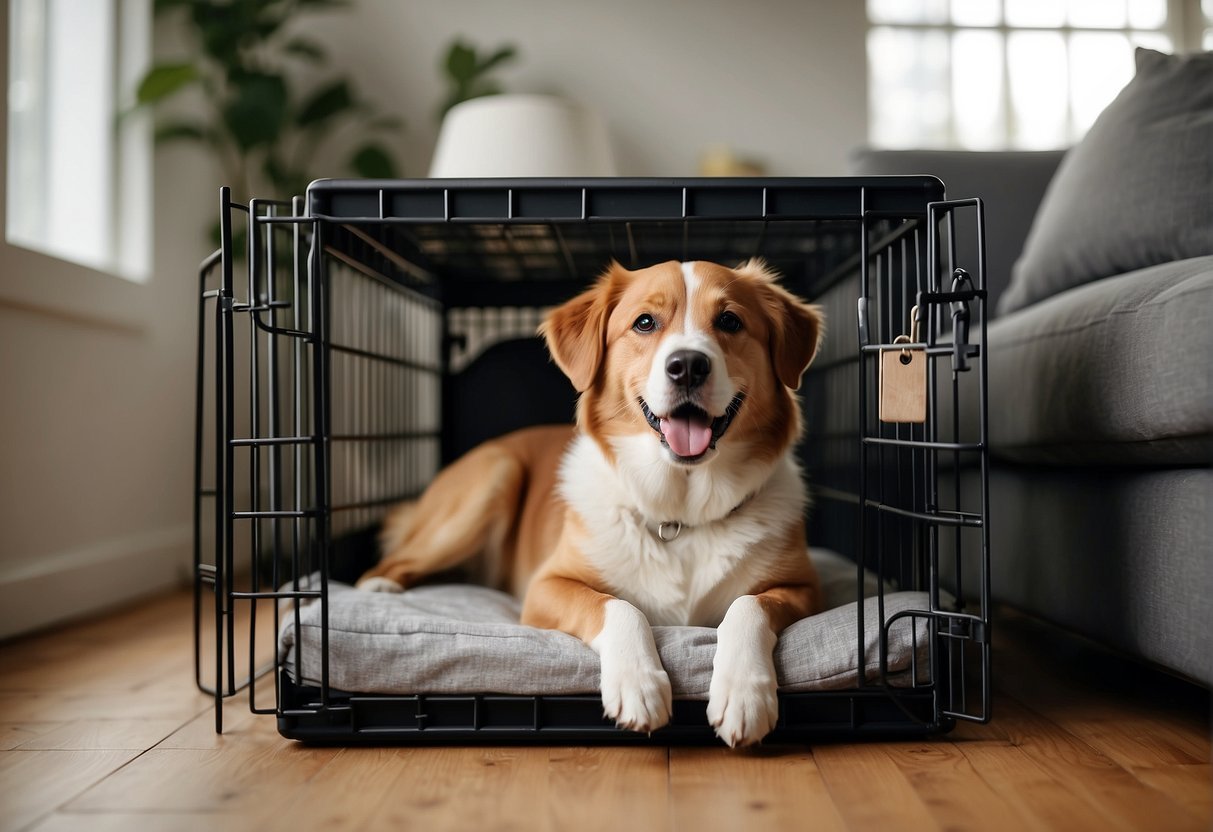
Creating a crate routine is essential to make sure your new puppy or dog feels at home while also keeping potty training on track. A consistent schedule helps establish a sense of security and order for your pet, making the crate a safe environment.
Meal Times
- Set regular meal times: Serving your dog meals at the same time every day will help them understand when to expect food. Place the food dish inside the crate, leaving the door open as they eat during the first few days. This practice reinforces the crate as a pleasant space.
- Gradually increase crate time after meals: Post-mealtime is great for your dog to rest and digest, and can help in associating the crate with relaxation and safety.
Potty Breaks
- Potty training consistency: Take your dog out for a potty break immediately upon waking, after playtime, and within 10 to 30 minutes after every meal.
- Recognize the signs: Keep an eye out for cues that it’s time for a break, like restlessness or sniffing around, and always lead them to the same spot. This creates a strong routine around their bodily needs.
Remember to praise your dog and offer treats for successfully doing their business outside, cementing these good behaviors in your everyday routine.
Addressing Crate Training Challenges
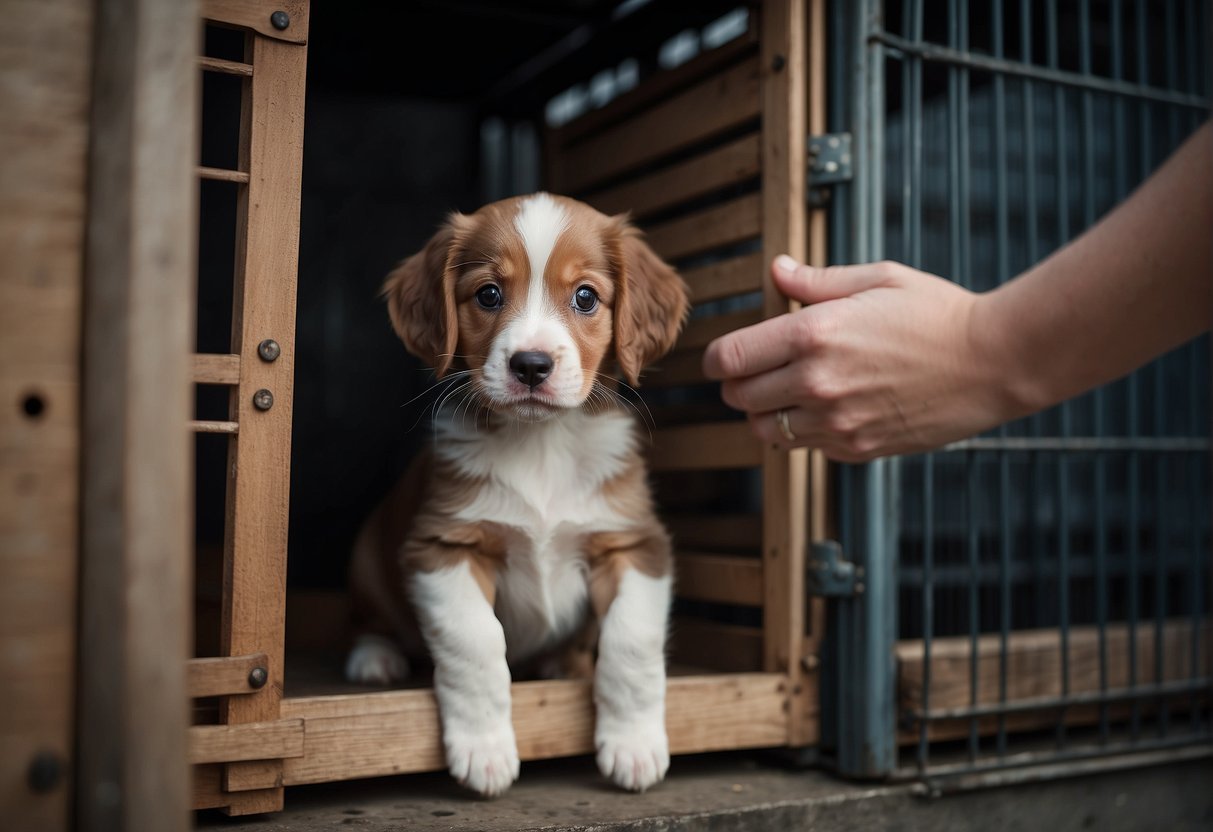
Whining and Anxiety
When faced with whining or signs of anxiety during crate training, consider these points:
- Consistency is Key: Use a calm voice and reassuring manner whenever you approach the crate, associating it with positive experiences.
- Training Treats: Incorporate training treats to reinforce calm behavior.
If your dog is exhibiting signs of separation anxiety, provide a favorite toy to help them relax, and ensure they have had plenty of exercise before crating. If whining persists, evaluate the duration they are crated and consider if it’s too long.
Reluctance and Fear
To address reluctance and fear:
- Positive Association:
- Place meals inside the crate.
- Offer treats or favorite toys only when your dog enters the crate.
- Training Steps:
- Start with short periods and gradually increase crate time.
- Encourage them to relax inside with the door open, to begin.
Always approach training moments with patience, as rushing can lead to a negative association with the crate. Make the space comfortable, and avoid forcing your dog into the crate, as this can heighten anxiety and fear.
Remember, successful crate training takes time. Your dog will eventually view their crate as a safe haven.
Advanced Crate Training Tips

Embarking on advanced crate training can greatly benefit both you and your dog, creating a safe haven for them and peace of mind for you.
Leaving Your Dog Alone
When you start to leave your dog alone in the crate, it’s important to begin with short periods of time and gradually increase the duration.
Ensure your dog is comfortable and has something to occupy them, like a puzzle dog toy or Kong toy, which you can stuff with treats to keep their mind at ease.
Always start with the door open allowing them to explore and enter at their own will.
Over time, as your dog starts to “den” in the crate naturally, incorporate a verbal cue to signify it’s okay to enter their space, reinforcing this behavior as positive.
Consider using a remote treat dispenser to reward your dog while they’re in the crate, even when you’re not in the same room. This can help reinforce good behavior and provide comfort to your dog while in the crate.

Crate Training Adult Dogs
For adult dogs, patience is key also. They may not have the positive association with a crate that a puppy might develop as easily.
Start by placing treats or their favorite toy inside the crate, encouraging them to venture in. Keep the door open at first to let them explore safely and without pressure.
As your dog becomes more comfortable with the crate, you can leave them for longer periods. However, if they’re not yet housetrained, it’s vital to keep initial crating sessions short or consider hiring a pet sitter for extended absences.
Don’t hesitate to a professional dog trainer for tailored advice and step-by-step guidance.
What Crate Should I Choose?

When choosing a dog crate, it’s crucial to consider the type of crate that will suit your dog’s needs and the appropriate size to ensure their comfort and safety.
Types of Dog Crates
There are several types of dog crates available, each with their own advantages.
A wire dog crate is well-ventilated and often collapsible for easy storage, making it a popular choice among dog owners.
On the other hand, a plastic dog crate is more enclosed which can be comforting to dogs and is approved for airline travel.
- Wire Dog Crate: Ideal for home use, offering good airflow and visibility.
- Plastic Dog Crate: Best for travel, especially air travel, and for dogs who prefer a cozy space.
- Furniture Style: Made to blend in with your home decor and look like another nice piece of furniture
You’ll find these options readily available at your local pet supply stores. Deciding on the type of crate depends on your dog’s personality, the intended use of the crate, and your personal preferences for home aesthetics and portability.
Make sure to choose a crate that your pupper will be comfortable in and love… since it’ll be like his little house within your home.
Conclusion
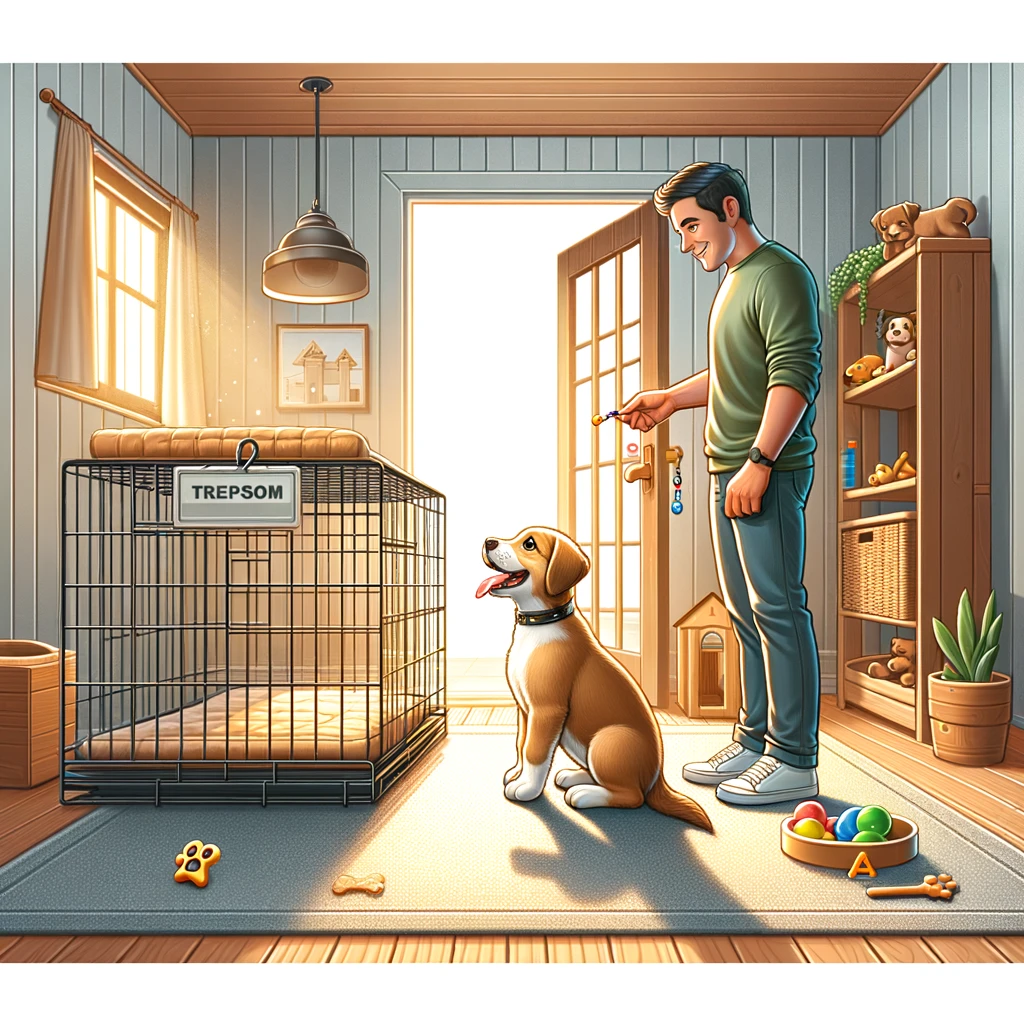
In wrapping up our journey through the ins and outs of dog crate training, we’ve uncovered the secret to not just a well-behaved pooch, but to creating a sanctuary for our furry family members that aligns perfectly with our living spaces.
From selecting the ideal crate that doubles as chic decor to mastering the art of positive reinforcement, we’ve navigated the challenges and celebrated the milestones of crate training together.
As we close this chapter, keep in mind that patience, consistency, and a sprinkle of love are your best allies in making your dog’s crate training journey a resounding success.



